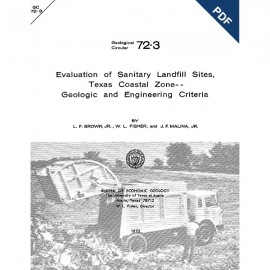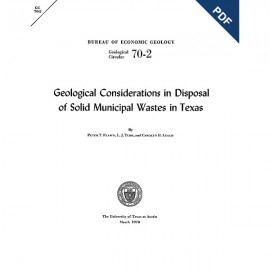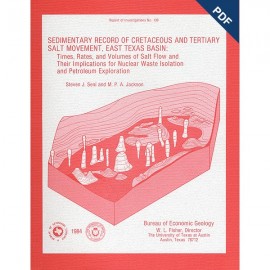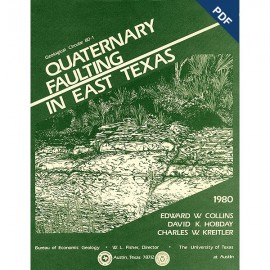Reports of Investigations
-
Books & Reports
- Reports of Investigations
- Guidebooks
- Udden Series
- Geological Circulars
- Down To Earth
- Atlases of Major Oil and Gas Reservoirs
- Texas Memorial Museum Publications
- Environmental Geologic Atlas of the Texas Coastal Zone
- Mineral Resource Circulars
- Other Reports
- Seminars and Workshops
- Handbooks
- Submerged Lands of Texas
- Symposia
- Annual Reports
- Open File Reports
-
Maps & Cross Sections
- Thematic Maps
- Miscellaneous Maps, Charts & Sections
- Geologic Atlas of Texas
- STATEMAP Project Maps
- Geologic Quadrangle Maps
- Cross Sections
- Highway Geology Map
- Energy and Mineral Resource Maps
- Shoreline Change and Other Posters
- Wilcox Group, East Texas, Geological / Hydrological Folios
- Bouguer Gravity Atlas of Texas
- River Basin Regional Studies
- Featured Maps
- Posters
- Teachers & the Public
-
Geological Society Publications
- Gulf Coast Association of Geological Societies
- Alabama Geological Society
- Austin Geological Society
- Corpus Christi Geological Society
- Houston Geological Society
- Lafayette Geological Society
- Mississippi Geological Society
- New Orleans Geological Society
- South Texas Geological Society
- GCS SEPM Publications
- Historic BEG & UT Series
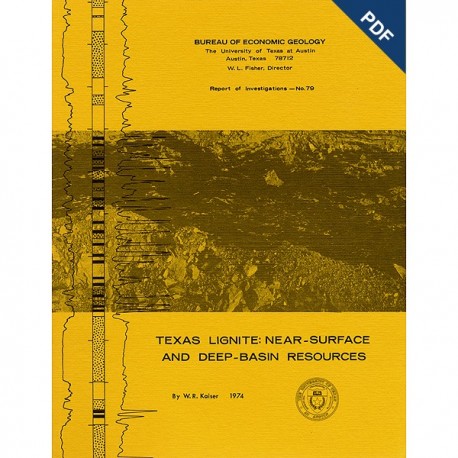
Texas Lignite: Near-Surface and Deep-Basin Resources. Digital Download
RI0079D
A free, digital version of this publication can be found on: Texas ScholarWorks
To purchase a print version (if available): RI0079
RI0079D. Texas Lignite: Near-Surface and Deep-Basin Resources, by W. R. Kaiser. 70 p., 22 figs., 7 tables, 1 appendix, 1974. Downloadable PDF.
To purchase this publication in book format, please order RI0079.
ABSTRACT
Lignite or low-rank coal is a major energy resource in Texas, providing energy since 1850. Prior to 1930, and the advent of abundant natural gas and oil, lignite was a major energy source. Today it is again assuming a substantial role in energy generation with the operation or scheduled construction by 1980 of lignite-fueled, steam-electric plants (up to 1500-megawatt capacities) near Alcoa, Fairfield, Athens, Mt. Pleasant, and Tatum. Future utilization of Texas lignite is likely in the production of synthetic gases, liquid fuels, and chemical feed stocks. Total statewide production of lignite is currently estimated at 8 to 10 million short tons annually.
Texas lignite resources, mainly situated in East and Central Texas north of the Colorado River, are large. Potential statewide resources at depths of less than 200 feet or available to conventional surface mining are estimated at 10.4 billion short tons. To this is added deep-basin lignite, a huge potential resource at depths of 200 to 5,000 feet below the surface, available through in situ recovery methods. More than 100 billion tons have been mapped, equivalent on a Btu basis to 277 billion barrels of oil. Utilization is technically feasible, but future development will depend on energy needs, dwindling fossil-fuel reserves, an unrealized potential of nuclear energy, and the larger question of national energy policy.
Environmental problems connected with the utilization of near-surface lignite are land use and disturbance, air and thermal pollution, water allocation and quality, and waste disposal. At the moment, sulfur oxides and particulates, because of their effect on the respiratory tract, are the air pollutants of prime concern to public health. The environmental impact, except for air pollution, is about the same whether lignite is used in steam-electric plants or gasification plants. Underground gasification poses the potential threat of groundwater contamination and surface subsidence, but avoids major land disturbance and waste disposal problems.
Lignite is found as near-surface and deep-basin deposits throughout the Texas Gulf Coastal Plain. Near-surface lignite occurs in two elongate bands stretching from the Rio Grande (Webb and Starr Counties) to the Red River (Bowie County) and Angelina River (Angelina County). Deep-basin lignite occurs coastward and downdip from the near-surface occurrences. The principal lignite deposits are found in the Wilcox Group (lower Eocene), while deposits of secondary importance in terms of resources and grade are found in the Yegua Formation and Jackson Group (upper Eocene). Lignite occurs as a component facies of ancient fluvial, deltaic, and lagoonal rocks in East, Central and Southeast, and South Texas, respectively.
The highest grade and most extensive resources occur north of the Colorado River in the Wilcox Group in East and Central Texas. On a dry basis, sulfur content is 1.0 to 1.4 percent, ash content 12 to 14 percent, and heating value 10,500 to 11,000 Btu per pound. There is a correlation between grade and geologic occurrence: deltaic lignite is the best quality, fluvial lignite is intermediate in quality, and lagoonal lignite is poorest in quality.
Keywords: Central Texas, coal, East Texas, energy resources, Jackson Group, lignite, Yegua Formation
Citation
Kaiser, W. R., 1974, Texas Lignite: Near-Surface and Deep-Basin Resources: The University of Texas at Austin, Bureau of Economic Geology, Report of Investigations No. 79, 70 p. doi.org/10.23867/RI0079D

